Cyber Monday Offer is Here! Subscribe by December 5 to Get 3 Months Free!
Learn More
Table of Contents

Experience Better Practice Management Today!
Starting at $28.05/month
No Credit Card Required

Experience Better Practice Management Today!
Starting at $30/month
No Credit Card Required
As a mobile healthcare practitioner, setting the right pricing can be one of the most important decisions for your business.
Pricing isn’t one-size-fits-all, especially when you're working in different locations with varying client expectations.
The flexibility to adjust your rates based on where you're serving will not only help maximize your earnings but also position you as a premium service provider.
Flat-rate pricing doesn’t take into account the differences between areas, and that’s where geofenced online booking from Noterro GO can help.
So, let’s discuss how you can go about it and customize your pricing by the areas you serve.
Every area you serve comes with its own set of challenges and opportunities. You might find that certain neighborhoods have clients who are willing to pay more for the convenience of home visits. In contrast, others may be more budget-conscious or located in areas with lower disposable income.
With flat-rate pricing, you risk undercharging in affluent areas where clients expect to pay more for high-quality, convenient care.
Alternatively, you might overcharge in budget-sensitive zones, potentially turning away clients who might otherwise have benefited from your services.
The key here is flexibility.
By tailoring your service and pricing to the specific areas you serve, you can ensure you're charging what your service is worth, no matter where you are.
When it comes to setting premium prices, it's crucial to first identify the areas where these prices will have the most impact and then create a strategy for the same.
The first step in setting premium prices is identifying where to implement them. Start by looking at your own data.
Export past appointments from Noterro, or any other clinic management solution you used, to identify high-density areas where you’ve seen consistent bookings.
Then, use tools like Census Data, Zillow income heatmaps, and Facebook Audience Insights to identify affluent neighborhoods in your service area.
You can further validate affluence by examining business density—areas with a high concentration of wellness centers, boutique gyms, or spas typically indicate higher-income zones.
Finally, compare competitor pricing in your service zones by visiting other mobile practitioner websites to see where they’re positioning themselves.
Pay close attention to where clients rebook, leave generous tips, or make comments like, “You should charge more.”
These are strong indicators that a specific area is willing to pay more for your service. Similarly, tracking cancellation and rescheduled rates can help identify areas where clients are highly committed to showing up, indicating high perceived value.
It’s also helpful to ask clients informally where they heard about you. If they mention being referred by a neighbor or friend in a premium area, that’s a signal that you may want to adjust your pricing to match the demand.
Once you've identified premium zones, it’s time to set your pricing. Start with a base hourly rate that reflects your standard services. Then, adjust the rate by adding a multiplier for the following factors:
When setting your prices, consider the travel time and extra costs involved in serving clients at a distance. Travel time impacts your day, and the longer the distance, the more effort and costs you incur. This includes:
Higher-income areas typically justify higher pricing because clients in these neighborhoods expect top-tier service, especially when it comes to mobile healthcare. Affluent clients are often willing to pay a premium for:
When pricing for affluent zones, consider adjusting your rates to reflect the added value of your service. For instance, a 10-20% increase over standard pricing may be appropriate in these neighborhoods, especially if you’re offering high-end treatments or specialized services.
Not all services are created equal. More complex treatments, such as osteopathy, deep tissue massage, or chiropractic adjustments, warrant higher prices due to the expertise and time involved. Factors to consider include:
For services with a higher complexity, consider adding a set fee or a percentage to your base rate to cover these specialized demands.
The time and day of the week can significantly impact demand for your services, especially for mobile practitioners. Premium pricing is often justified during:
Don’t forget to consider hidden costs like tolls, paid parking, or the time it takes to set up and break down your equipment.
To effectively manage the pricing adjustments for different service zones, it’s helpful to create three distinct pricing tiers. These tiers will allow you to charge based on the value and demand in each zone:
Here’s another interesting read for you: The Psychology of Pricing: How to Set Rates Patients Will Pay and Value
Affluent areas are often willing to pay more for the convenience, expertise, and personalized service that comes with mobile healthcare. Here, you're not just providing a service—you're offering time savings, privacy, and comfort. For many, these factors are worth the premium price.
People in higher-income areas typically value their time more and are more likely to pay for a service that brings healthcare to their door, especially if it fits within their busy lifestyle.
Premium pricing becomes an expectation rather than an exception when your service aligns with the high standards and value they seek.
Gather more insights for your mobile practice: How to Start a Mobile Health Clinic in 2025
Managing pricing and service areas manually can be time-consuming. Noterro GO’s geofenced booking automates this process, allowing you to set custom service zones and adjust pricing without the hassle.
Noterro GO’s geofenced booking allows you to define custom service zones directly on your map.
This feature lets you assign specific services and prices to each area. With this tool, clients will automatically see the services and pricing applicable to their address, ensuring you don’t have to manually adjust pricing every time you book an appointment.
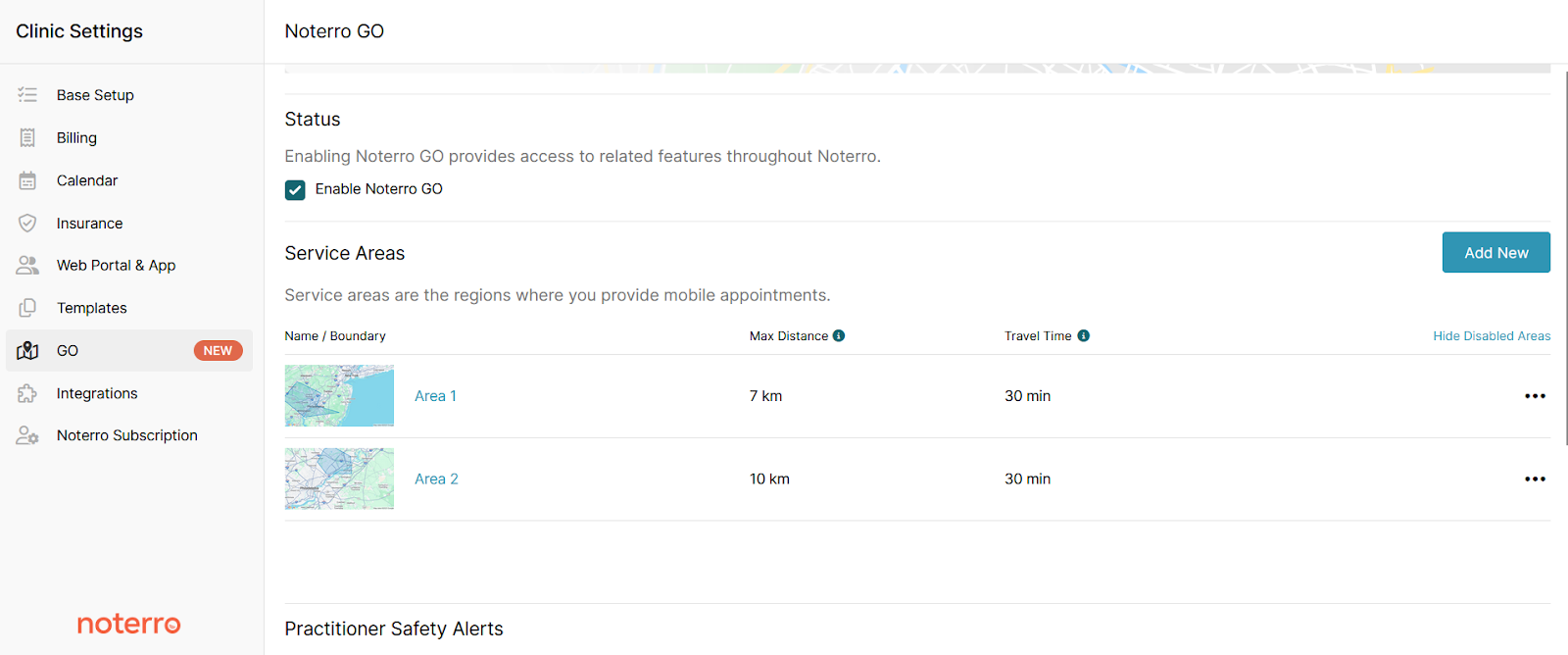
With Noterro, setting up area-specific pricing is simple and quick. Here’s a step-by-step process for you:
1. Log into your Noterro Admin account, go to ‘Settings,’ and then ‘Base Setup.’
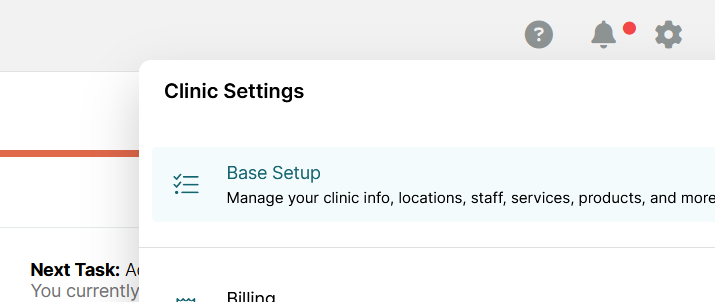
2. Move down to the ‘Services’ section and create two categories for your service type. Take the image below as an example. For Physiotherapy services, we’ve created two categories: “On-going Therapy” and “On-going Premium” and set the rates for each accordingly.
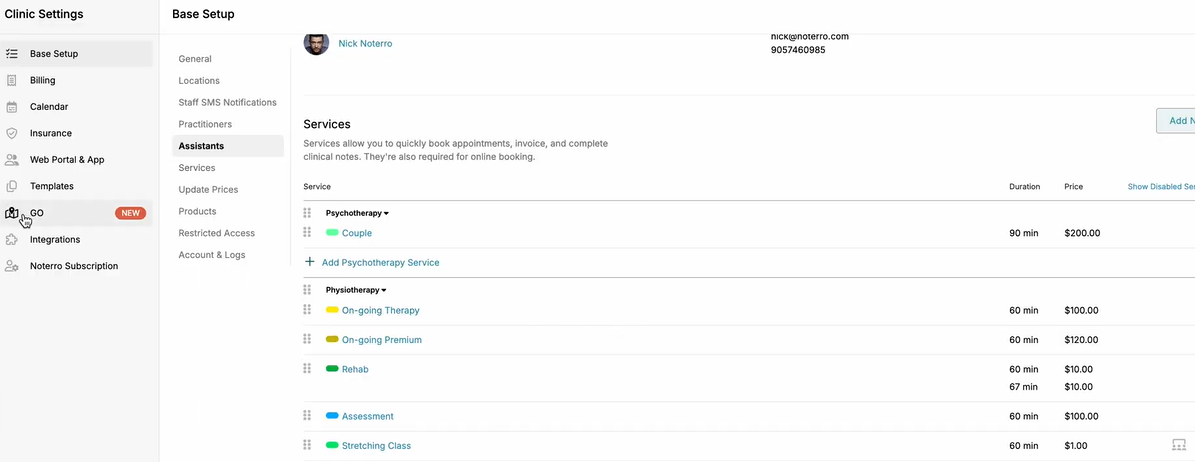
3. Now, click on the 'GO' option from the menu.
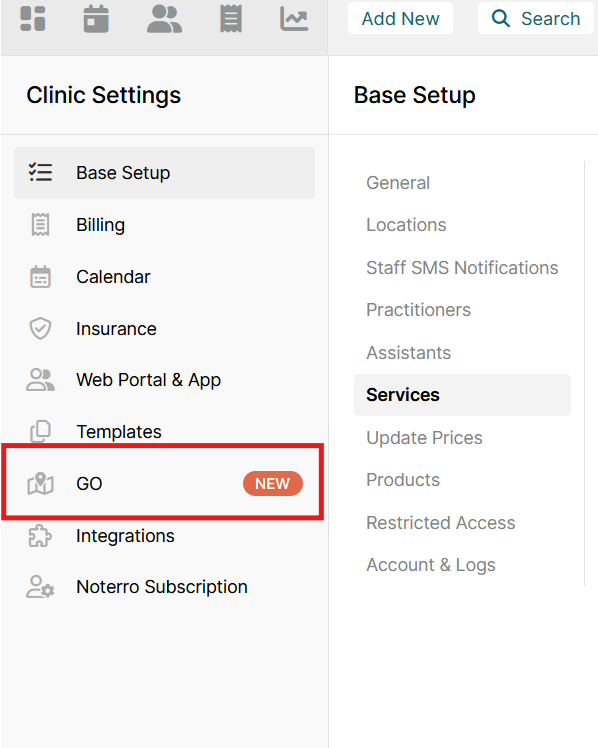
4. Under 'Service Ares' click on the 'Add new' option and create dedicated services area for your regular and premium services separately.

5. Now, add all the required information like the name of the area, distance limit, travel time and area you want to save.
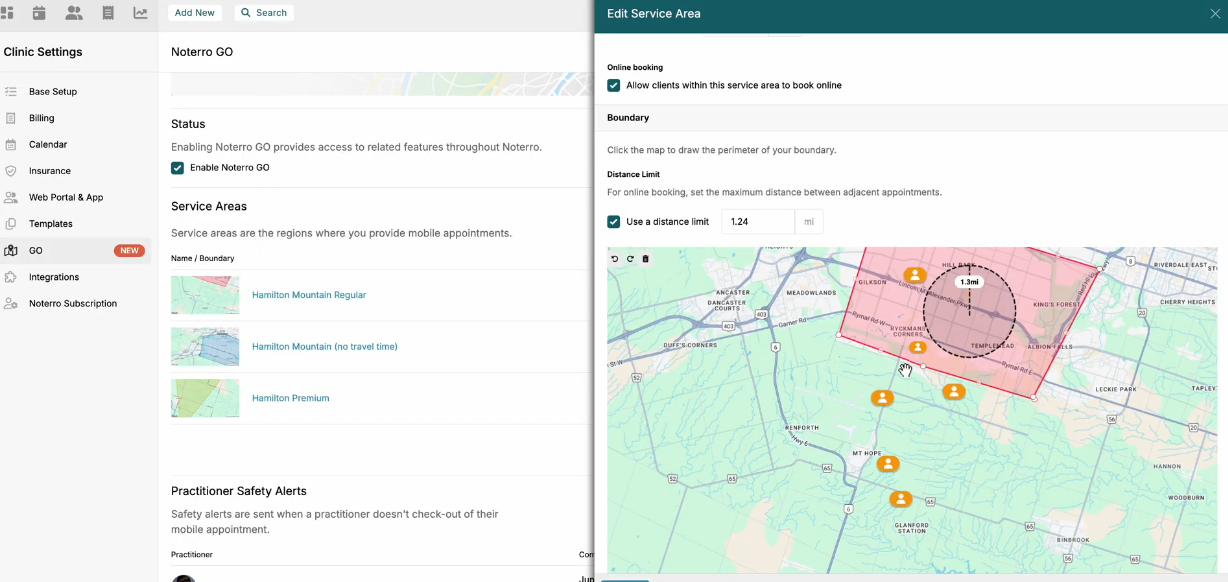
6. Now, add the services you want to offer each area (e.g: "On-going therapy" or "On-going premium") and save "click" and it's done!
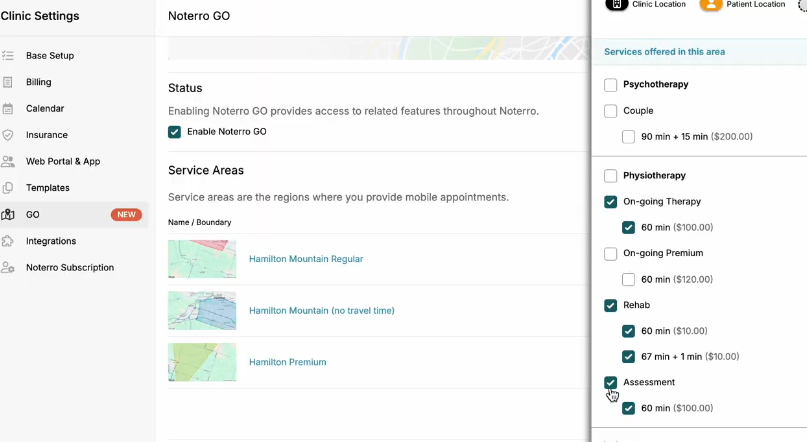
As a bonus, you can restrict bookings to certain zones, preventing long, unprofitable drives unless you’re compensated accordingly.
Note:
If you want to try this feature and require assistance, start a 14-day free trial, and our experts will guide you through it.
Know more about Noterro GO:
Geofencing offers several advantages for mobile clinics, helping streamline operations while ensuring clarity and efficiency for both you and your clients:
Here’s something to scale your practice: How to Successfully Manage a Clinic and Mobile Practice on Wheels
Setting different pricing won’t work if you cannot successfully communicate this difference to your clients. So, here’s how you can do it:
When communicating your premium pricing, emphasize the convenience and expertise you offer. Instead of focusing on what you charge, focus on the value clients receive. For example:
Showcase your credentials, experience, and the specialized services you provide. Use your branding (logos, colors, testimonials) to signal premium quality. This helps clients understand why they’re paying more for a premium service.
Your booking page should clearly display the pricing for each service zone. Clients should know exactly what they’re paying for before confirming the appointment. Consider adding confirmation messages or emails that reinforce:
You can also use Noterro’s reminders to reinforce professionalism, reduce no-shows, and make clients feel more confident in their choices.
As a mobile healthcare practitioner, you have the flexibility to adjust your pricing based on where you’re working.
By using data, geofencing, and a tiered pricing structure, you can ensure that your rates reflect the value you offer to your clients in every area you serve.
With Noterro GO, you can automate the entire process, save time, and focus on providing excellent care. Start pricing smarter today and position yourself as a premium service provider in every area you serve.
One of the main mistakes to avoid when pricing by area is inconsistency. It’s important to ensure your pricing is uniform across all platforms, such as your website, booking system, and any promotional materials. Inconsistent pricing can confuse potential clients and damage trust. Additionally, overcomplicating your pricing structure can lead to misunderstandings. Keep your pricing straightforward and transparent. Finally, don’t forget to factor in hidden costs like travel time, parking fees, and setup time. These costs can add up quickly, and neglecting them may lead to underpricing your services.
To keep your mobile practice’s pricing competitive while charging premium rates, it’s essential to stay informed about local competitors' pricing and adjust accordingly. Research your competitors to see where your pricing fits in relation to the value you provide. You can also implement tiered pricing to cater to clients with varying budgets, offering a range of options without lowering the premium quality of your service. This allows you to stay competitive while still positioning your practice as a top-tier option for clients seeking high-quality care.
When marketing your premium mobile services, focus on highlighting the value and benefits you offer. Instead of just emphasizing the price, make it clear why your service is worth the investment, whether it’s the convenience, specialized care, or expertise you bring to the table. Using testimonials from satisfied clients and showcasing the exclusive nature of your services can help potential clients see the value. By positioning your service as a luxury or specialized experience, clients will understand that the higher price is tied to the quality and convenience they receive.
If you start receiving negative feedback on your pricing, it’s important to listen carefully and assess whether the feedback is valid. If many clients are expressing concerns, it could be an indication that your pricing needs to be adjusted. Consider offering discounts or payment plans for those who feel the cost is too high, but make sure to maintain the premium value of your service. If the feedback is isolated, you can respond by explaining the value they’re receiving for the price and emphasizing the personalized nature of your mobile services.
Yes, you can offer special rates or discounts to repeat clients in premium areas as a way to reward loyalty. This can be an effective strategy for building long-term relationships with your clients. However, it’s important to ensure that these discounts do not undermine the premium nature of your service. You can offer bundled services or loyalty programs that add value without devaluing your pricing structure. Make sure the discounts feel exclusive and reflect the continued trust and value of your returning clients.
Tags



